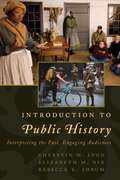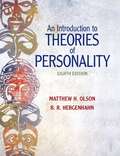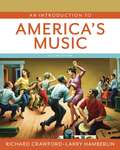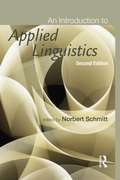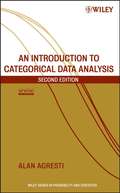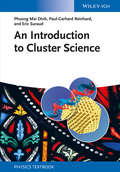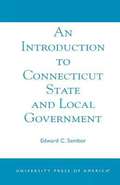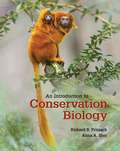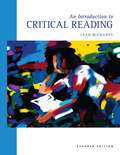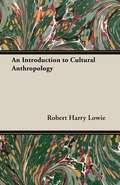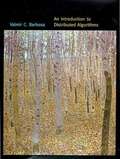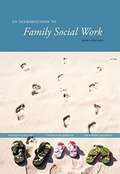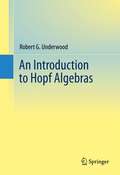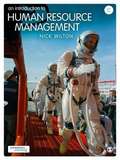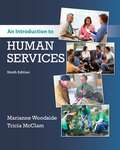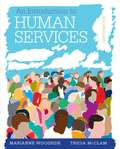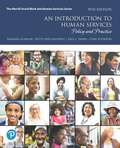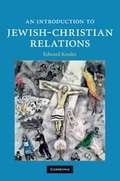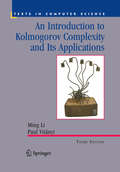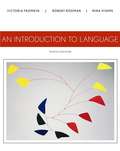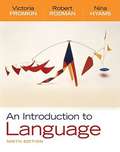- Table View
- List View
An Introduction To Public History: Interpreting The Past, Engaging Audiences
by Cherstin Lyon Elizabeth Nix Rebecca ShrumIntroduction to Public History: Interpreting the Past, Engaging Audiences is a brief foundational textbook for public history. It is organized around the questions and ethical dilemmas that drive public history in a variety of settings, from local community-based projects to international case studies. <p><p> This book is designed for use in undergraduate and graduate classrooms with future public historians, teachers, and consumers of history in mind. The authors are practicing public historians who teach history and public history to a mix of undergraduate and graduate students at universities across the United States and in international contexts. <p><p> This book is based on original research and the authors' first-hand experiences, offering a fresh perspective on the dynamic field of public history based on a decade of consultation with public history educators about what they needed in an introductory textbook. Each chapter introduces a concept or common practice to students, highlighting key terms for student review and for instructor assessment of student learning. The body of each chapter introduces theories, and basic conceptual building blocks intermixed with case studies to illustrate these points. Footnotes credit sources but also serve as breadcrumbs for instructors who might like to assign more in-depth reading for more advanced students or for the purposes of lecture development. Each chapter ends with suggestions for activities that the authors have tried with their own students and suggested readings, books, and websites that can deepen student exposure to the topic.
An Introduction To Theories Of Personality
by B. R. Hergenhahn Matthew H. OlsonAn Introduction to Theories of Personality, , 8/e -- is just the standalone book For Sophomore/Junior level courses in Theories of Personality, Personality, or Personality Psychology. Using a theorist-by-theorist approach, this comprehensive introduction to personality theory gives students the history of psychology with practical information to help them understand their own lives and their relationships with others. Primary sources, abundant biographical information and supporting research are used to descibe and detail each theorist, presenting the theories of personality in an accessible and unbiased way.
An Introduction to America's Music
by Richard Crawford Larry HamberlinRichard Crawford and Larry Hamberlin show how the lively interactions between the folk, popular, and classical spheres have made American music resonate with audiences around the world. Students will learn how to listen critically to eighty-eight pieces in all the major styles and genres, while gaining a clearer understanding of music's role in the history of American society, business, and technology.
An Introduction to Applied Linguistics (Second Edition)
by Norbert SchmittAn Introduction to Applied Linguistics, Second Edition provides a complete, authoritative and up-to-date overview of the state of the field. Each of the 15 chapters offers an extended survey of a central element of Applied Linguistics and is co-authored by two leading international specialists, thus ensuring a full and balanced treatment of the topic covered. The book is divided into three sections: a description of language and language use; essential areas of enquiry; and the four skills and testing. An Introductory chapter familiarises readers with key issues and recurrent themes whilst hands-on activities and further reading sections for each chapter encourage practical analysis and wider reading. For this new edition, each chapter has been fully revised in line with new research and thinking in Applied Linguistics. With its accessible style, broad coverage and practical focus, this book is ideal for students of applied linguistics, TESOL, and second language pedagogy as well as practicing teachers and researchers wishing to update their knowledge.
An Introduction to Art Therapy Research
by Lynn KapitanAn Introduction to Art Therapy Research is a pragmatic text that introduces readers to the basics of research design in quantitative and qualitative methodology written in the language of art therapy, with particular attention to the fields unique aspects, current thinking, and exemplars from published art therapy research studies. This combination of a broad, standard approach to research design plus art therapies particular perspective and major contributions to the subject make the text suitable for courses in introductory research, survey of art therapy history and literature, art therapy assessment, and ethics. The book includes strategies for evaluating research reports and writing for peer-reviewed publication, features that make the text of special value to students, practitioners, doctoral candidates, and academics writing for publication. An online instructor's manual with student resources is available and offers material to enhance the pedagogical features of the text.
An Introduction to Categorical Data Analysis
by Alan AgrestiThe use of statistical methods for categorical data is ever increasing in today's world. An Introduction to Categorical Data Analysis, Second Edition provides an applied introduction to the most important methods for analyzing categorical data. This new edition summarizes methods that have long played a prominent role in data analysis, such as chi-squared tests, and also places special emphasis on logistic regression and other modeling techniques for univariate and correlated multivariate categorical responses. This Second Edition features: Two new chapters on the methods for clustered data, with an emphasis on generalized estimating equations (GEE) and random effects models A unified perspective based on generalized linear models An emphasis on logistic regression modeling An appendix that demonstrates the use of SAS(r) for all methods An entertaining historical perspective on the development of the methods Specialized methods for ordinal data, small samples, multicategory data, and matched pairs More than 100 analyses of real data sets and nearly 300 exercises Written in an applied, nontechnical style, the book illustrates methods using a wide variety of real data, including medical clinical trials, drug use by teenagers, basketball shooting, horseshoe crab mating, environmental opinions, correlates of happiness, and much more. An Introduction to Categorical Data Analysis, Second Edition is an invaluable tool for social, behavioral, and biomedical scientists, as well as researchers in public health, marketing, education, biological and agricultural sciences, and industrial quality control.
An Introduction to Category Theory
by H. SimmonsCategory theory provides a general conceptual framework that has proved fruitful in subjects as diverse as geometry, topology, theoretical computer science and foundational mathematics. Here is a friendly, easy-to-read textbook that explains the fundamentals at a level suitable for newcomers to the subject. Beginning postgraduate mathematicians will find this book an excellent introduction to all of the basics of category theory. It gives the basic definitions; goes through the various associated gadgetry, such as functors, natural transformations, limits and colimits; and then explains adjunctions. The material is slowly developed using many examples and illustrations to illuminate the concepts explained. Over 200 exercises, with solutions available online, help the reader to access the subject and make the book ideal for self-study. It can also be used as a recommended text for a taught introductory course.
An Introduction to Cluster Science
by Paul-Gerhard Reinhard Phuong Mai Dinh Eric SuraudFilling the need for a solid textbook, this short primer in cluster science is ideal for a one-semester lecture for advanced undergraduate students. It is based on a series of lectures given by the well-established and recognized authors for the past ten years. The book covers both the basics of the domain as well as up-to-date developments. It can be divided roughly into two parts. The first three chapters introduce basic concepts of cluster science. Chapter 1 provides a general introduction, complemented by chapter 2 on experimental and chapter 3 on theoretical aspects. The second half of the book is devoted to a systematic presentation of free cluster properties, and to a thorough discussion of the impact of clusters in other domains of science. These explicitly worked-out links between cluster physics and other research areas are unique both in terms of fundamental aspects and of applications, and cannot be found elsewhere in the literature. Also suitable for researchers outside of the field looking for an introduction to cluster science.
An Introduction to Compressive Sensing
by Wotao Yin Mona Sheikh Jason LaskaIntroduction to compressive sensing. This course introduces the basic concepts in compressive sensing. We overview the concepts of sparsity, compressibility, and transform coding. We then review applications of sparsity in several signal processing problems such as sparse recovery, model selection, data coding, and error correction. We overview the key results in these fields, focusing primarily on both theory and algorithms for sparse recovery. We also discuss applications of compressive sensing in communications, biosensing, medical imaging, and sensor networks.
An Introduction to Connecticut State and Local Government
by Edward C. SemborThis is a comprehensive text for political science courses focused on state and local government.Included are discussions on the governor, General Assembly, the judicial branch, political parties, interest groups and elections.
An Introduction to Conservation Biology
by Richard Primack Anna Sher<p>This is a book well suited for a wide range of undergraduate courses, as both a primary text for conservation biology courses and a supplement for ecological and environmental science courses. <p>New coauthor Anna Sher joins longtime Sinauer author Richard Primack in creating a book that combines the readability of Primack's A Primer of Conservation Biology with the depth and coverage of his larger textbook, Essentials of Conservation Biology. The result is a book well suited for a wide range of undergraduate courses, as both a primary text for conservation biology courses and a supplement for ecological and environmental science courses. <p>Using the chapter framework of the current Primer as a springboard, the authors have added three chapters focused on population biology conservation tools (Chapter 7), restoration ecology (Chapter 10), and the future of conservation (Chapter 12). Sustainable development, ex situ conservation, and other key topics have been expanded and updated with hundreds of new examples, explanations, citations, and figures to enhance learning and excitement for the subject. Dr. Sher has mined her experience of having taught conservation biology using Dr. Primack's texts for over a decade to fine-tune the presentation of difficult concepts, particularly in economics and politics. Coverage of recent conservation biology events in the news—such as the poaching of Cecil the Lion, the first papal encyclical on the environment, and the international Paris Accord on climate change—keeps the content fresh and current.</p>
An Introduction to Critical Reading
by Leah MccraneyThis unique college reading text gives students experience reading and evaluating poetry, short stories, essays, and textbook chapters. An innovative Instructor's Manual gives instructors a wealth of teaching ideas and background material on each piece with a focus on critical thinking.
An Introduction to Distributed Algorithms
by Valmir C. BarbosaAn Introduction to Distributed Algorithms takes up some of the main concepts and algorithms, ranging from basic to advanced techniques and applications, that underlie the programming of distributed-memory systems such as computer networks, networks of workstations, and multiprocessors. Written from the broad perspective of distributed-memory systems in general it includes topics such as algorithms for maximum flow, program debugging, and simulation that do not appear in more orthodox texts on distributed algorithms. Moving from fundamentals to advances and applications, ten chapters--with exercises and bibliographic notes--cover a variety of topics. These include models of distributed computation, information propagation, leader election, distributed snapshots, network synchronization, self- stability, termination detection, deadlock detection, graph algorithms, mutual exclusion, program debugging, and simulation. All of the algorithms are presented in a clear, template- based format for the description of message-passing computations among the nodes of a connected graph. Such a generic setting allows the treatment of problems originating from many different application areas. The main ideas and algorithms are described in a way that balances intuition and formal rigor--most are preceded by a general intuitive discussion and followed by formal statements as to correctness complexity or other properties.
An Introduction to European Law
by Robert SchützeThought-provoking and accessible in approach, this book offers a classic introduction to European law. Taking a clear structural framework, it guides the student through the subject's core elements from its creation and enforcement to the workings of the internal market. A flowing writing style combines with the use of illustrations and diagrams throughout the text to ensure the student understands even the most complex of concepts. This succinct and enlightening overview is required reading for all students of European law. Clearly sets out the key principles and central topics taught on EU law courses. Succinct overview which also indicates key debates and controversies in the field. Numerous illustrations reinforce key concepts to aid understanding.
An Introduction to Family Social Work
by Catheleen Jordan Heather Coleman Don CollinsThis text is intended for Methods/Practice with Families (Mezzo) courses in Social Work as a basic primer that introduces students to an overview of practice with families. It can also be used in Generalist Practice courses in which instructors want to emphasize work with families. Likewise, it is appropriate for paraprofessional, two-year human services programs.
An Introduction to Hopf Algebras
by Robert G. UnderwoodWith wide-ranging connections to fields from theoretical physics to computer science, Hopf algebras offer students a glimpse at the applications of abstract mathematics. This book is unique in making this engaging subject accessible to advanced undergraduate and beginning graduate students. After providing a self-contained introduction to group and ring theory, the book thoroughly treats the concept of the spectrum of a ring and the Zariski topology. In this way the student transitions smoothly from basic abstract algebra to Hopf algebras. The importance of Hopf orders is underscored with applications to algebraic number theory, Galois module theory and the theory of formal groups. By the end of the book, readers will be familiar with established results in the field and ready to pose research questions of their own.
An Introduction to Human Resource Management
by Dr Nick WiltonThe second edition of Nick Wilton's An Introduction to Human Resource Management continues to provide an engaging and holistic overview of the role of Human Resource Management in its contemporary context. It reflects on current trends, the labour market and the global economy while offering a critical yet accessible treatment of both theoretical and practical issues relating to Human Resource Management. <P><P> * New Full Colour Layout makes the text easy to read and navigate <P> * HR in Practice boxes illustrate how theory can be applied in practice <P> * Ethical Insights present ethical considerations for budding practitioners<P> * Global Insights highlight practices around the world <P> * Research Insights invite you to explore academic research <P> * Case Studies relate theory to real organisations such as Tesco, Intel and Lloyds TSB <P> * Self-test questions are ideal for revision <P> * Further Online Reading provides free access to scholarly journal articles <P> * Glossary and Definitions explain key terms <P> * Podcasts summarise key topics and highlight employability skills <P> Visit: www.sagepub.co.uk/wilton2 to access additional learning resources including extended case studies, chapter summaries, podcasts and journal articles.<P> This book is essential reading for undergraduate, postgraduate and MBA students, including those studying for their CIPD qualifications.
An Introduction to Human Services
by Marianne Woodside Tricia McClamInterested in a practical introduction to the human service profession? If the answer's yes, then this book is for you. <p><p> Drawing on their extensive experience, the authors define human services, review the historical development of advocacy, and examine service delivery models and processes. They thoroughly explore the current state of this rapidly evolving profession as well as the essential skills you need to succeed within it. <p><p> You'll gain a solid grounding in such fundamental concepts as serving the whole person, using an interdisciplinary approach, interacting with helper and client, preparing generalists, understanding multicultural influences, and empowering clients. Detailed case studies give you frontline perspectives -- and prepare you to effectively address issues you're likely to encounter as a helping professional.
An Introduction to Human Services (Eighth Edition)
by Marianne Woodside Tricia McclamOffers an introduction to the human services profession. Based on the authors' extensive experience as practitioners, educators, and researchers, this text defines human services, reviews the historical development of the field, provides an overview of the profession, and emphasizes the skills needed to succeed as a human services practitioner
An Introduction to Human Services: Policy and Practice
by Barbara Schram Betty Mandell Paul Dann Lynn PetersonComplete, up-to-date coverage of social welfare programs and policies with special coverage of how history, politics, and the economy shape these programs This text puts the field of human services into a historical context, provides insights into the social welfare field, and gives concrete examples of how primary intervention strategies are put into daily practice in human service agencies. It presents the many options offered in the field of human services and discusses the stresses that a human service worker will face in day-to-day work, with practical suggestions for avoiding burnout. The text compares the U.S. social welfare systems to systems in other countries, and uses a strong multicultural and social systems approach that distinguishes it from other texts. Teaching & Learning Experience Personalize Learning — MyHelpingLab delivers proven results in helping students succeed, provides engaging experiences that personalize learning, and comes from a trusted partner with educational expertise and a deep commitment to helping students and instructors achieve their goals. Engage Students — Outstanding pedagogy, including examples, cases, anecdotes, and interviews, keeps students interested. Explore Current Issues — Contemporary issues are incorporated throughout the text to provide students with the most up-to-date coverage; topics include: cyberbullying, immigration, and health care reform. Support Instructors — An Instructor's Manual and Test Bank, Computerized Test Bank (MyTest), MyHelpingLab with Pearson eText, and PowerPoint presentations, and BlackBoard and WebCT Test Item File provide instructors with additional support. Note: MyHelpingLab does not come automatically packaged with this text. To purchase MyHelpingLab, please visit: www.myhelpinglab.com or you can purchase a valuepack of the text + MyHelpingLab (at no additional cost). VP: 0205060560
An Introduction to Jewish-Christian Relations
by Edward KesslerRelations between Christians and Jews over the past two thousand years have been characterised to a great extent by mutual distrust and by Christian discrimination and violence against Jews. In recent decades, however, a new spirit of dialogue has been emerging, beginning with an awakening among Christians of the Jewish origins of Christianity, and encouraging scholars of both traditions to work together. An Introduction to Jewish-Christian Relations sheds fresh light on this ongoing interfaith encounter, exploring key writings and themes in Jewish-Christian history, from the Jewish context of the New Testament to major events of modern times, including the rise of ecumenism, the horrors of the Holocaust, and the creation of the state of Israel. This accessible theological and historical study also touches on numerous related areas such as Jewish and interfaith studies, philosophy, sociology, cultural studies, international relations and the political sciences.
An Introduction to Kolmogorov Complexity and Its Applications (Texts in Computer Science)
by Ming Li Paul M. B. Vitányi"The book is outstanding and admirable in many respects. ... is necessary reading for all kinds of readers from undergraduate students to top authorities in the field." Journal of Symbolic Logic Written by two experts in the field, this is the only comprehensive and unified treatment of the central ideas and applications of Kolmogorov complexity. The book presents a thorough treatment of the subject with a wide range of illustrative applications. Such applications include the randomness of finite objects or infinite sequences, Martin-Loef tests for randomness, information theory, computational learning theory, the complexity of algorithms, and the thermodynamics of computing. It will be ideal for advanced undergraduate students, graduate students, and researchers in computer science, mathematics, cognitive sciences, philosophy, artificial intelligence, statistics, and physics. The book is self-contained in that it contains the basic requirements from mathematics and computer science. Included are also numerous problem sets, comments, source references, and hints to solutions of problems. New topics in this edition include Omega numbers, Kolmogorov-Loveland randomness, universal learning, communication complexity, Kolmogorov's random graphs, time-limited universal distribution, Shannon information and others.
An Introduction to Language
by Victoria Fromkin Robert Rodman Nina HyamsAssuming no prior knowledge of linguistics, AN INTRODUCTION TO LANGUAGE, Tenth Edition, is appropriate for a variety of fields--including education, languages, psychology, cognitive science, anthropology, English, and teaching English as a Second Language (TESL)--at both the undergraduate and graduate levels. This completely updated edition retains the clear descriptions, humor, and seamless pedagogy that have made the book a perennial best-seller, while adding new information and exercises that render each topic fresh, engaging, and current.
An Introduction to Language (9th Edition)
by Victoria Fromkin Robert Rodman Nina HyamsAssuming no prior knowledge of linguistics, AN INTRODUCTION TO LANGUAGE, Ninth Edition, is appropriate for a variety of fields--including education, languages, psychology, anthropology, English, and teaching English as a Second Language (TESL)--at both the undergraduate and graduate levels. This completely updated edition retains the clear descriptions, humor, and seamless pedagogy that have made the text a perennial best-seller, while adding new information and exercises that render each topic fresh, engaging, and current.
